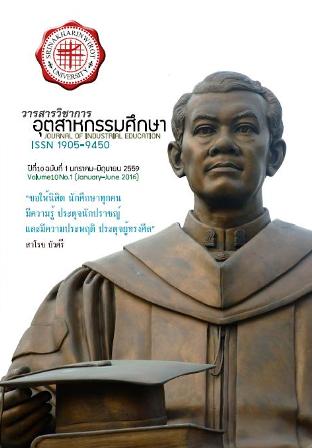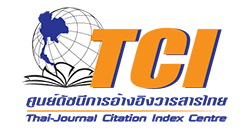รูปแบบการจัดสรรงบประมาณค่าใช้จ่ายรายหัวสำหรับนักศึกษาการศึกษานอกระบบระดับการศึกษาขั้นพื้นฐานของสำนักงานส่งเสริมการศึกษานอกระบบและการศึกษาตามอัธยาศัย
Abstract
บทคัดย่อ การวิจัยเรื่องการพัฒนารูปแบบการจัดสรรงบประมาณค่าใช้จ่ายรายหัวสำหรับนักศึกษาการศึกษานอกระบบระดับการศึกษาขั้นพื้นฐานของสำนักงานส่งเสริมการศึกษานอกระบบและการศึกษาตามอัธยาศัยมีจุดมุ่งหมายเพื่อศึกษาค่าใช้จ่ายรายหัวที่ตรงตามสภาพความเป็นจริงสร้างและประเมินรูปแบบการจัดสรรงบประมาณค่าใช้จ่ายรายหัวสำหรับนักศึกษาการศึกษานอกระบบระดับการศึกษาขั้นพื้นฐาน วิธีดำเนินการวิจัยประกอบด้วย 3 ขั้นตอน ได้แก่ 1) ศึกษาค่าใช้จ่ายรายหัวที่ตรงตามสภาพความเป็นจริง โดยใช้แบบสอบถามปลายเปิดจำนวน 3 ฉบับ จากกลุ่มตัวอย่างที่ได้มาด้วยการสุ่มอย่างเป็นระบบ (Systematic Random Sampling) ได้แก่ ผู้บริหารสถานศึกษา 81 คน ครูผู้สอน 155 คน และนักศึกษา 757 คน 2) สร้างรูปแบบการจัดสรรงบประมาณค่าใช้จ่ายรายหัว จากผลการวิเคราะห์ค่าใช้จ่ายรายหัวที่ตรงตามสภาพความเป็นจริง สถิติที่ใช้ในการวิเคราะห์ข้อมูล คือ ค่าความถี่ ค่าร้อยละ ค่าเฉลี่ย ค่าเบี่ยงเบนมาตรฐาน ค่า t-test และค่า One-way ANOVA แล้วให้ผู้เชี่ยวชาญ9 คน ประเมินความสอดคล้องและความเป็นไปได้ของรูปแบบอยู่ในระดับมากที่สุด และ 3) ประเมินรูปแบบการจัดสรรงบประมาณค่าใช้จ่ายรายหัว โดยกลุ่มตัวอย่างผู้บริหารสถานศึกษา จำนวน 90 คน ได้มาด้วยการสุ่มตัวอย่างเป็นระบบ และสถิติที่ใช้ในการวิเคราะห์ข้อมูล คือ ค่าความถี่ ค่าร้อยละ ค่าเฉลี่ย และค่าเบี่ยงเบนมาตรฐาน ผลการวิจัยพบว่า 1. รูปแบบการจัดสรรงบประมาณค่าใช้จ่ายรายหัวสำหรับนักศึกษาการศึกษานอกระบบระดับการศึกษาขั้นพื้นฐานประกอบไปด้วย 5 องค์ประกอบ ดังนี้ 1.1หลักการจัดการศึกษานอกระบบ:1) การจัดการศึกษาตลอดชีวิต 2) หลักสูตรการศึกษานอกระบบระดับการศึกษาขั้นพื้นฐาน และ 3) ปรัชญาการศึกษาตลอดชีวิต 1.2 กฎหมาย: 1) การจัดการศึกษาขั้นพื้นฐาน: จัดให้อย่างทั่วถึงมีคุณภาพ ส่งเสริมให้เกิดการเรียนรู้ตลอดชีวิต และ 2) การจัดสรรงบประมาณ : อย่างเท่าเทียม เป็นธรรม มีประสิทธิภาพ อย่างทั่วถึง 1.3ประสิทธิภาพของการจัดสรรงบประมาณค่าใช้จ่ายรายหัว:1) ความถูกต้อง เหมาะสม2) ความประหยัด3) มีประโยชน์ และ 4) ทันเวลา 1.4 นโยบาย: 1) การศึกษานอกระบบระดับการศึกษาขั้นพื้นฐาน 2) การจัดสรรงบประมาณแบบมุ่งเน้นผลงาน (Performance-Based Budgeting และ 3) การจัดการศึกษาขั้นพื้นฐาน 1.5 งบประมาณ: 1) ประเภท/สัดส่วนของค่าใช้จ่ายรายหัวที่ตรงตามสภาพความเป็นจริงของสถานศึกษาประกอบด้วยด้านการบริหารสถานศึกษา ร้อยละ 18.74 ด้านการเรียนการสอนตามหลักสูตร ร้อยละ 53.45 ด้านการจัดกิจกรรมพัฒนาผู้เรียน ร้อยละ 8.84 ด้านการแนะนำให้คำปรึกษา ร้อยละ 1.64 และด้านการพัฒนาสื่อและแหล่งเรียนรู้ 17.33 2) วิธีการจัดสรรงบประมาณค่าใช้จ่ายรายหัว (2.1) ใช้เกณฑ์การปันส่วนค่าใช้จ่ายรายหัวตามหลักสูตรการศึกษานอกระบบระดับการศึกษาขั้นพื้นฐาน (2.2) ปัจจัยการจัดสรรงบประมาณค่าใช้จ่ายรายหัว :ขนาดสถานศึกษา ขนาดจังหวัด พื้นที่ในเมืองและนอกเมือง และหน่วยงานต้นสังกัดส่วนกลางและส่วนภูมิภาค (2.3)จัดสรรงบประมาณค่าใช้จ่ายรายหัวที่ตรงสภาพความเป็นจริงกับจำนวนนักศึกษาที่เป็นจริง (2.4) จัดสรรงบประมาณค่าใช้จ่ายรายหัวของครูผู้สอนให้เต็มจำนวนตามสัดส่วนการเรียนการสอน 2. ผลการการประเมินรูปแบบการจัดสรรงบประมาณค่าใช้จ่ายรายหัวสำหรับนักศึกษาการศึกษานอกระบบระดับการศึกษาขั้นพื้นฐานโดยผู้บริหารสถานศึกษา พบว่า ในภาพรวม และทุกรายองค์ประกอบมีความเป็นไปได้นำรูปแบบไปปฏิบัติอยู่ระดับมาก คำสำคัญ : รูปแบบการจัดสรรงบประมาณค่าใช้จ่ายรายหัว, การศึกษานอกระบบระดับการศึกษาขั้นพื้นฐาน Abstract: The research entitled “The Per HeadExpenditure Allocation Model for the Basic Nonformal EducationStudents Under the Office of the Nonformaland Informal Education”had the objectives to study the authentic cost per headstudent, create and evaluate a model of budget allocation per head for students of nonformal education basic education level. The research methodology consisted of3 stages. 1) Studying the authentic cost per head studentusing 3 open-ended questionnaireswith the samples acquired by systematic random sampling. They consisted of 81 school administrators, 155 teachers and 757 students. 2) Creating a model of budget allocation per head based on the analysis results of the authentic cost per head student. The statistics used in data analysis were frequency, percentage. mean, standard deviation, t-test and One-Way ANOVA. Then 3 experts were asked to evaluate the congruence and feasibility of the model. And 3) Evaluating the model of budget allocation per head by 90 school administrator samples, acquired by systematic random sampling. The statistics used in data analysis were frequency, percentage. mean, and standard deviation. The research results reveal as follows. 1. The model of budget allocation per head based on the analysis results of the authentic cost per head studentfor students of nonformal education basic education level consisted of 5 components as follows. 1.1 Principles of nonformal education management: 1) Life longeducation management, 2) Nonformal and informal education curricula, and 3) Long life education philosophy. 1.2 Law: 1) Basic education management: providing on a nationwide basis, being of quality, and promoting lifelong learning, 2) Budget allocation: equalit, well distribution, fairness, efficiency. 1.3 Budget allocation per head efficiency: 1) Accuracy and appropriatenes, 2) saving, 3) benefits, and 4) timeliness. 1.4 Policies: 1) nonformal education basic education level, 2) performance-based budgeting, and 3) basic education management. 1.5 Budget: 1) Types/proportions of authentic cost per head of schools consisted of school administration 18.74%, learning and teaching following the curricula 53.45%, management of learner development activities 8.84%, guidance and counseling 1.64%, and development of media and learning resources 17.33%. 2) Budget allocation per head methods: (2.1) Overhead cost criteria following non-formal education basic education level curricula. (2.2) Budget allocation per head factors: school sizes, province sizes, urban and rural areas, and central and regional affiliations. (2.3) Budget allocation of authentic cost per head and real numbers of students. (2.4) Budget allocation of cost per head for teachers at full cost following learning and teaching proportions. 2. The school administrators’ evaluation results of the model of budget allocation per head for students of non-formal education basic education level by overall and individual components found the model being practically feasible at the high level. Keyword: Model for the per head expenditure allocation,The basic nonformal education studentsDownloads
Download data is not yet available.
Downloads
Issue
Section
บทความวิจัย




